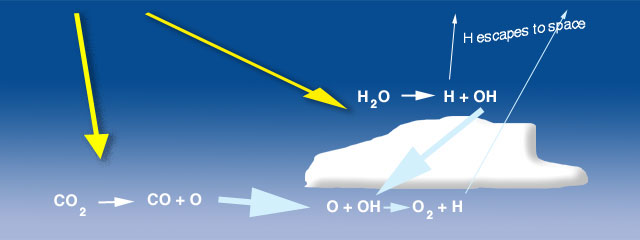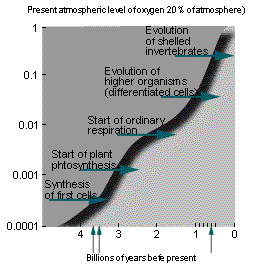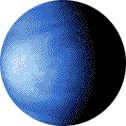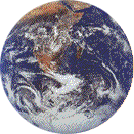What Was The Chemical Makeup Of Earth's Atmosphere During The Triassic Period
Evolution of the Atmosphere: Composition, Construction and Energy
I inhale slap-up draughts of space,
The east and west are mine, and the n and the s are mine
I am larger, better than I thought,
I did not know I held so much goodness - all seems beautiful to me.
- Song of the Open Route, Walt Whitman
| Introduction To Global Modify I Lecture Notes | Format for Printing | |||
| Early Atmosphere, Oceans, and Continents | Composition of the Atmosphere | Development of the Atmosphere | Summary | |
Driving Questions:
- How did the temper evolve into what it is today?
- What gases in the atmosphere are important to life and how are they maintained?
- What natural variations occur in atmospheric constituents and what are the important time scales for change?
1. The Earliest Temper, Oceans, and Continents
After loss of the hydrogen, helium and other hydrogen-containing gases from early Globe due to the Lord's day's radiations, primitive Earth was devoid of an atmosphere. The first temper was formed by outgassing of gases trapped in the interior of the early Earth, which still goes on today in volcanoes.For the Early Earth, extreme volcanism occurred during differentiation, when massive heating and fluid-like motility in the mantle occurred. Information technology is probable that the bulk of the atmosphere was derived from degassing early in the Earth's history. The gases emitted by volcanoes today are in Table one and in Figure.
Oxygen in the Atmosphere
Life started to have a major impact on the environment once photosynthetic organisms evolved. These organisms, blue-dark-green algae (pic of stromatolite, which is the stone formed by these algae), fed off atmospheric carbon dioxide and converted much of it into marine sediments consisting of the shells of sea creatures.
While photosynthetic life reduced the carbon dioxide content of the atmosphere, it also started to produce oxygen. For a long time, the oxygen produced did not build up in the atmosphere, since it was taken upwardly by rocks, equally recorded in Banded Iron Formations (BIFs; movie) and continental red beds. To this mean solar day, the majority of oxygen produced over time is locked up in the aboriginal "banded stone" and "scarlet bed" formations. Information technology was not until probably merely 1 billion years agone that the reservoirs of oxidizable rock became saturated and the free oxygen stayed in the air.
The oxidation of the the mantle rocks may have played an important office in the rise of oxygen. Information technology has been hypothesized the the alter from predominantly submarine to subaerial volcanoes may have also led to a reduction in volcanic emission of reduced gases.
In one case oxygen had been produced, ultraviolet light split the molecules, producing the ozone UV shield every bit a by-product. Simply at this point did life move out of the oceans and respiration evolved. We will discuss these issues in greater detail later on in this course.
Early Oceans
The Early atmosphere was probably dominated at kickoff past water vapor, which, as the temperature dropped, would rain out and form the oceans. This would have been a deluge of truly global proportions an resulted in farther reduction of CO2. And then the atmosphere was dominated past nitrogen, but there was certainly no oxygen in the early atmosphere. The authorization of Banded-Iron Formations (BIFs; encounter movie) before 2.5Ga indicates that Atomic number 26 occurred in its reduced state (Fe2+). Whereas reduced Fe is much more soluble than oxidized Fe (Fe3+), information technology chop-chop oxidizes during transport. Yet, the dissolved O in early oceans reacted with Fe to class Iron-oxide in BIFs. As soon as sufficient O entered the atmosphere, Fe takes the oxidized state and is no longer soluble. The first occurrence of redbeds, a sediments that contains oxidized iron, marks this major transition in Earth's atmosphere.Early Continents
Lava flowing from the partially molten interior spread over the surface and solidified to form a thin chaff. This crust would take melted and solidified repeatedly, with the lighter compounds moving to the surface. This is called differentiation. Weathering by rainfall broke upward and altered the rocks. The finish consequence of these processes was a continental land mass, which would accept grown over time. The well-nigh popular theory limits the growth of continents to the kickoff 2 billion years of the Globe.2. Evolution of the Present Atmosphere
The development of the atmosphere could exist divided into 4 split stages:- Origin
- Chemic/ pre-biological era
- Microbial era, and
- Biological era.
The Biological Era - The Formation of Atmospheric Oxygen
The biological era was marked by the simultaneous decrease in atmospheric carbon dioxide (COii) and the increment in oxygen (O2) due to life processes. We need to understand how photosynthesis could have led to maintenance of the ~twenty% present-day level of O2. The build up of oxygen had three major consequences that we should note here.Firstly, Eukaryotic metabolism could just have begun in one case the level of oxygen had built up to about 0.2%, or ~i% of its present abundance. This must have occurred by ~2 billion years ago, co-ordinate to the fossil record. Thus, the eukaryotes came most as a result of the long, steady, but less efficient earlier photosynthesis carried out past Prokaryotes.

Effigy 1. Photolysis of water vapor and carbon dioxide produce hydroxyl and atomic oxygen, respectively, that, in plough, produce oxygen in small-scale concentrations. This process produced oxygen for the early on temper before photosynthesis became dominant.Oxygen increased in stages, first through photolysis (Figure 1) of water vapor and carbon dioxide by ultraviolet energy and, possibly, lightning:
HtwoO -> H + OH
produces a hydroxyl radiacal (OH) and
CO2 -> CO+ O
produces an atomic oxygen (O). The OH is very reactive and combines with the O
O + OH -> O2 + H
The hydrogen atoms formed in these reactions are lite and some small-scale fraction excape to space allowing the O2 to build to a very low concentration, probably yielded only about 1% of the oxygen available today.
Secondly, once sufficient oxygen had accumulated in the stratosphere, information technology was acted on by sunlight to course ozone, which immune colonization of the land. The first evidence for vascular plant colonization of the country dates back to ~400 million years ago.
Thirdly, the availability of oxygen enabled a diversification of metabolic pathways, leading to a bully increase in efficiency. The bulk of the oxygen formed once life began on the planet, principally through the process of photosynthesis:
6CO2 + 6HtwoO <--> CsixH12O6 + 6O2
where carbon dioxide and water vapor, in the presence of light, produce organics and oxygen. The reaction can go either way as in the case of respiration or disuse the organic matter takes up oxygen to grade carbon dioxide and water vapor.
Life started to take a major impact on the surround once photosynthetic organisms evolved. These organisms fed off atmospheric carbon dioxide and converted much of information technology into marine sediments consisting of the innumerable shells and decomposed remnants of sea creatures.
 |
| Cumulative history of O2 by photosynthesis through geologic fourth dimension. |
While photosynthetic life reduced the carbon dioxide content of the atmosphere, it also started to produce oxygen. The oxygen did non build up in the temper for a long fourth dimension, since information technology was absorbed by rocks that could be easily oxidized (rusted). To this day, most of the oxygen produced over time is locked up in the ancient "banded rock" and "red bed" stone formations found in aboriginal sedimentary stone. Information technology was non until ~1 billion years ago that the reservoirs of oxidizable rock became saturated and the free oxygen stayed in the air. The figure illustrates a possible scenario.
We take briefly mentioned the difference betwixt reducing (electron-rich) and oxidizing (electron hungry) substances. Oxygen is the well-nigh important example of the latter blazon of substance that led to the term oxidation for the procedure of transferring electrons from reducing to oxidizing materials. This consideration is important for our give-and-take of atmospheric evolution, since the oxygen produced by early photosynthesis must have readily combined with any bachelor reducing substance. It did non have far to look!
We have been able to outline the steps in the long fatigued out procedure of producing present-day levels of oxygen in the atmosphere. We refer here to the geological evidence.
Banded Atomic number 26 Formations
When the oceans first formed, the waters must have dissolved enormous quantities of reducing atomic number 26 ions, such as Atomic number 262+. These ferrous ions were the consequences of millions of years of rock weathering in an anaerobic (oxygen-costless) surround. The showtime oxygen produced in the oceans by the early prokaryotic cells would have quickly been taken up in oxidizing reactions with dissolved iron. This oceanic oxidization reaction produces Ferric oxide Atomic number 262O3 that would have deposited in ocean floor sediments. The primeval testify of this process dates back to the Banded Iron Formations, which accomplish a peak occurrence in metamorphosed sedimentary rock at least 3.5 billion years old. Most of the major economic deposits of iron ore are from Banded Iron formations. These formations, were created as sediments in ancient oceans and are establish in rocks in the range ii - 3.v billion years former. Very few banded iron formations have been found with more than recent dates, suggesting that the connected production of oxygen had finally exhausted the adequacy of the dissolved fe ions reservoir. At this signal another process started to take up the available oxygen.
Carmine Beds
Once the ocean reservoir had been exhausted, the newly created oxygen found another big reservoir - reduced minerals available on the barren land. Oxidization of reduced minerals, such as pyrite FeS2 , exposed on land would transfer oxidized substances to rivers and out to the oceans via river flow. Deposits of Iron2O3 that are found in alternating layers with other sediments of state origin are known equally Scarlet Beds, and are found to date from 2.0 billion years agone. The earliest occurrence of red beds is roughly simultaneous with the disappearance of the banded iron formation, further evidence that the oceans were cleared of reduced metals before O2 began to diffuse into the atmosphere.Finally after some other i.5 billion years or so, the ruby bed reservoir became wearied too (although it is continually being regenerated through weathering) and oxygen finally started to accumulate in the atmosphere itself. This bespeak issue initiated eukaryotic cell development, land colonization, and species diversification. Peradventure this period rivals differentiation as the about important issue in World history.
The oxygen built up to today'southward value only after the colonization of land by light-green plants, leading to efficient and ubiquitous photosynthesis. The current level of 20% seems stable.

The Oxygen Concentration Problem.
Why does present-twenty-four hours oxygen sit at 20%? This is not a trivial question since significantly lower or higher levels would be dissentious to life. If we had < 15% oxygen, fires would not burn, yet at > 25% oxygen, even moisture organic matter would burn down freely.
The Early Ultraviolet Problem
The genetic materials of cells (DNA) is highly susceptible to damage by ultraviolet light at wavelengths most 0.25 µm. It is estimated that typical contemporary microorganisms would be killed in a thing of seconds if exposed to the full intensity of solar radiation at these wavelength. Today, of grade, such organisms are protected by the atmospheric ozone layer that finer absorbs calorie-free at these curt wavelengths, but what happened in the early Earth prior to the significant production of atmospheric oxygen? There is no problem for the original not-photosynthetic microorganisms that could quite happily have lived in the deep bounding main and in muds, well hidden from sunlight. But for the early photosynthetic prokaryotes, information technology must have been a matter of life and expiry.
Information technology is a classical "chicken and egg" problem. In lodge to go photosynthetic, early microorganisms must accept had access to sunlight, however they must have also had protection against the UV radiation. The oceans only provide limited protection. Since h2o does non absorb very strongly in the ultraviolet a depth of several tens of meters is needed for total UV protection. Maybe the organisms used a protective layer of the expressionless bodies of their brethren. Perhaps this is the origin of the stromatolites - algal mats that would have provided acceptable protection for those organisms buried a few millimeters in. Perhaps the early organisms had a protective UV-absorbing case fabricated up of disposable DNA - there is some intriguing evidence of unused mod elaborate repair mechanisms that allow sure cells to repair moderate UV harm to their DNA. Even so information technology was accomplished, we know that natural selection worked in favor of the photosynthetic microorganisms, leading to further diversification.
Fluctuations in Oxygen
The history of macroscopic life on Globe is divided into three great eras: the Paleozoic, Mesozoic and Cenozoic. Each era is so divided into periods. The latter one-half of the Paleozoic era, includes the Devonian catamenia, which ended nearly 360 million years ago, the Carboniferous period, which ended about 280 meg years ago, and the Permian flow, which ended about 250 million years ago.
According to recently developed geochemical models, oxygen levels are believed to have climbed to a maximum of 35 per centum and then dropped to a low of 15 percent during a 120-million-year period that ended in a mass extinction at the terminate of the Permian. Such a jump in oxygen would accept had dramatic biological consequences past enhancing diffusion-dependent processes such as respiration, allowing insects such as dragonflies, centipedes, scorpions and spiders to grow to very large sizes. Fossil records indicate, for example, that one species of dragonfly had a wing span of 2 1/2 feet.
Geochemical models point that well-nigh the close of the Paleozoic era, during the Permian period, global atmospheric oxygen levels dropped to most 15 percentage, lower that the current atmospheric level of 21 percent. The Permian period is marked by one of the greatest extinctions of both land and aquatic animals, including the behemothic dragonflies. But it is not believed that the driblet in oxygen played a significant role in causing the extinction. Some creatures that became specially adapted to living in an oxygen-rich environment, such every bit the large flying insects and other behemothic arthropods, yet, may have been unable to survive when the oxygen temper underwent dramatic modify.
iii. Composition of the Present Atmosphere
Comparing to Other Planets
The overall composition of the globe's temper is summarized below along with a comparison to the atmospheres on Venus and Mars - our closest neighbors.
| VENUS | EARTH | MARS | |
| SURFACE Force per unit area | 100,000 mb | 1,000 mb | 6 mb |
| COMPOSITION | |||
| COtwo | >98% | 0.03% | 96% |
| Nii | 1% | 78% | ii.v% |
| Ar | 1% | 1% | 1.v% |
| O2 | 0.0% | 21% | 2.5% |
| H2O | 0.0% | 0.1% | 0-0.one% |
 (more than on Mars) |  (more on Earth) |  (more on Mars) | |
The variations in concentration from the Globe to Mars and Venus event from the different processes that influenced the development of each atmosphere. While Venus is likewise warm and Mars is likewise cold for liquid water the Globe is at just such a distance from the Sun that h2o was able to grade in all three phases, gaseous, liquid and solid. Through condensation the h2o vapor in our atmosphere was removed over time to form the oceans. Additionally, because carbon dioxide is slightly soluble in water it as well was removed slowly from the atmosphere leaving the relatively scarce but unreactive nitrogen to build up to the 78% is holds today.
Electric current Composition
The unit of percentage listed here are for comparison sake. For nigh atmospheric studies the concentration is expressed as parts per million (by volume). That is, in a one thousand thousand units of air how may units would be that species. Carbon dioxide has a concentration of well-nigh 350 ppm in the temper (i.e. 0.000350 of the temper or 0.0350 percent).
Greenhouse Gases
 |
| Click to interactively explore Selective Absorbers. |
Radiative Properties
Objects that absorb all radiation incident upon them are called "blackbody" absorbers. The world is close to existence a blackness torso absorber. Gases, on the other hand, are selective in their absorption characteristics. While many gases practice not absorb radiations at all some selectively absorb only at certain wavelengths. Those gases that are "selective absorbers" of solar energy are the gases nosotros know every bit "Greenhouse Gases."
The interactive activity to the right allows you to visualize how each greenhouse gas selectively absorbs radiation. Wien's Law states that the wavelength of maximum emission of radiation is inversely proportional to the object's temperature. Using that police we know that the wavelength of maximum emission for the Sun is about 0.five µm (1 µm = 10-6 m) and the wavelength for maximum emission by the World is most ten µm. In the activity to the right see where the greenhouse gases absorb relative to those ii important wavelengths.
Sources and Sinks
Greenhouse Gases (autonomously from water vapor) include:
- Carbon Dioxide
- Chlorofluorocarbons (CFCs)
- Methane
- Nitrous Oxide
- Ozone
and each have dissimilar sources (emission mechanisms) and sinks (removal mechanisms) as outlined below.
Carbon Dioxide | |
| Sources | Released past the combustion of fossil fuels (oil, coal, and natural gas), flaring of natural gas, changes in land employ (deforestation, called-for and clearing state for agricultural purposes), and manufacturing of cement |
| Sinks | Photosynthesis and degradation to the body of water. |
| Importance | Accounts for nearly half of all warming potential caused by homo activeness. |
Marsh gas | |
| Sources | Landfills, wetlands and bogs, domestic livestock, coal mining, wet rice growing, natural gas pipeline leaks, biomass burning, and termites. |
| Sinks | Chemic reactions in the temper. |
| Importance | Molecule for molecule, methane traps heat 20-30 times more efficiently than CO2. Within fifty years it could become the most pregnant greenhouse gas. |
Nitrous Oxide | |
| Sources | Called-for of coal and wood, besides as soil microbes' digestion.. |
| Sinks | Chemical reactions in the atmosphere. |
| Importance | Long-lasting gas that eventually reaches the stratosphere where it participates in ozone destruction. |
| Sources | Ozone |
| Sources | Not emitted directly, ozone is formed in the temper through photochemical reactions involving nitrogen oxides and hydrocarbons in the presence of sunlight. |
| Sinks | Degradation to the surface, chemical reactions in the atmosphere. |
| Importance | In the troposphere ozone is a pollutant. In the stratosphere information technology absorbs hazardous ultraviolet radiation. |
| Chlorofluorocarbons (CFCs) | |
| Sources | Used for many years in refrigerators, automobile air conditioners, solvents, droplets propellants and insulation. |
| Sinks | Degradation occurs in the upper temper at the expenses of the ozone layer. Ane Chlorofluorocarbon molecule can initiate the devastation of every bit many as 100,000 ozone molecules. |
| Importance | The nigh powerful of greenhouse gases — in the atmosphere one molecule of CFC has well-nigh 20,000 times the estrus trapping ability on a molecule of COtwo. |
four. Summary
We adult a few useful tools for the study of biogeochemical cycles. These include the concepts of the reservoir, fluxes, and equilibria.
- Atmospheric evolution progressed in four stages, leading to the current situation. The atmosphere has non always been equally it is today - and it will modify again in the future. Information technology is closely controlled by life and, in plough, controls life processes. Complex feedback mechanisms are at play that we practise not yet understand.
- Oxygen became a primal atmospheric constituent due entirely to life processes. It congenital upwardly slowly over time, get-go oxidizing materials in the oceans and then on land. The current level (20%) is maintained past processes not yet understood.
- Old just before the Cambrian, atmospheric oxygen reached levels close plenty to today's to allow for the rapid evolution of the higher life forms. For the residuum of geologic fourth dimension, the oxygen in the atmosphere has been maintained by the photosynthesis of the green plants of the earth, much of information technology past dark-green algae in the surface waters of the ocean.
- Selective absorbers in our atmosphere keep the surface of the earth warmer than they would be without an atmosphere.
Copyright � Regents of the Academy of Michigan
What Was The Chemical Makeup Of Earth's Atmosphere During The Triassic Period,
Source: https://globalchange.umich.edu/globalchange1/current/lectures/deep_time/index.html
Posted by: watsonaccee1988.blogspot.com


0 Response to "What Was The Chemical Makeup Of Earth's Atmosphere During The Triassic Period"
Post a Comment